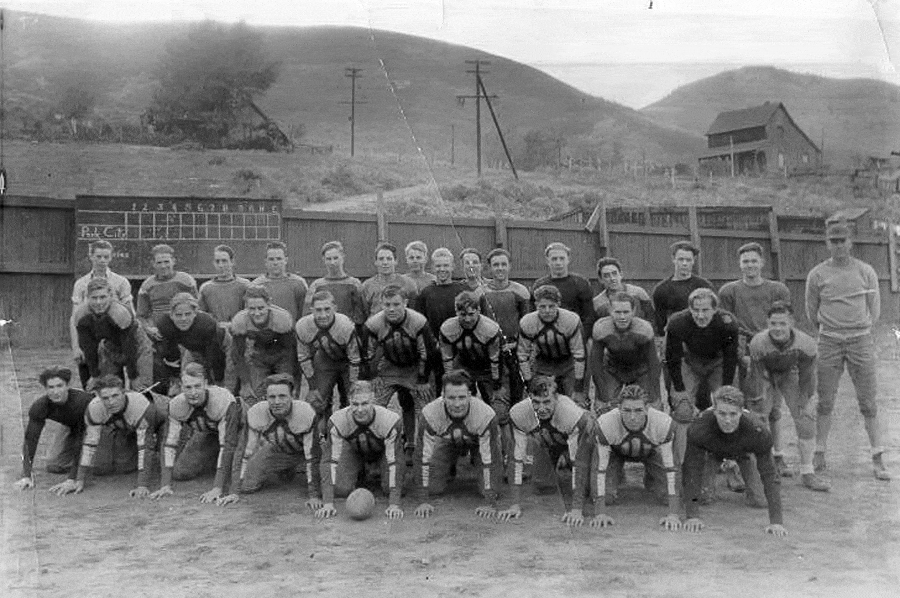John Leo “Jack” McKissick was born on September 6, 1918 in Park City. A stocky, but athletic boy, Jack was a walking stereotype in high school: star quarterback for the football team from his sophomore through senior years, varsity starter in basketball, and perhaps the most popular fellow in school – he was class president in his final three years. At times he was a bit of a bully too: the student reporter noted in the Park Record that “Jack McKissick, big, considerate fellow that he is, likes to trip the girls. More than one unfortunate female has been taken off her feet by him.”
Outside of school, Jack was a baseball star, playing on club teams (there was no high school team then) with grown men, and striking them out at a high rate as a reliable starting pitcher. The Park Record noted in one 1935 game, McKissick carried his team, saying “Jack McKissick probably realized today that it will do no good to scatter five hits over five innings and strike out eleven batters, and expect to win a game unless the other eight players [on his team] will act a bit sociable.”
McKissick provided most of the offensive production for the PCHS football team. Not only was he the quarterback (keep in mind that quarterbacks back then were essentially running backs – teams rarely threw in these early days), but he was also the team’s placekicker and punter. In one of his first starts at quarterback, Jack scored the only points of the Miners’ 1933 7-0 homecoming game victory against North Summit by running in a touchdown and kicking the extra point.
Of all the players on the team, McKissick typically received the most praise. The Park Record called him a “blazing young quarterback,” a “careful student of the game,” “sensational,” and “in every sense of the word a triple-threat man” since he could run, pass, and kick. The Morgan County News called him “sensational” and “outstanding” while the Provo Sunday Herald hailed him as a “line-hammering” runner.

Credit: Park City Historical Society & Museum, Pop Jenks Collection
Jack received All State honorable mention honors for the quarterback position in 1934 and 1935, his junior and senior campaigns. He also led his team to Summit Division titles, but never a state title (back then, all schools played in just one playoff pool no matter the size of the school; Park City usually had to play much larger schools). In 1936, Jack joined the Utah Utes football team, where he would share playing time at quarterback from his sophomore through senior years.
With the Utes, Jack helped his team to the first Skyline Conference championship in 1938. Then in 1939, as a senior, he was named one of the team captains. According to the Salt Lake Telegram, “McKissick’s election was a surprise to many, but Jack became considerable of a favorite with his mates during the team’s recent trip to Hawaii and the Sun Bowl game at El Paso, Texas, and his election was practically unanimous.” That same year, Jack earned All-Conference honorable mention honors for the quarterback position.
Jack played quarterback for the Utes and also continued his “triple-threat” abilities, spending time as their placekicker and punter. In his time on the team, he was known as “one of the hardest hitting backs on the Utah Squad,” and scored many of the team’s extra points in a drop-kick style. On offense, he was primarily used as a lead blocker, but ran and passed the ball as well.
After football, McKissick turned his attention to building a family. He had married Marjorie Greenwood in 1938 while attending the U. On June 17, 1944 he joined the Marines to serve in WWII and left for the Pacific theater that November. He was killed in action on March 11, 1945 at Iwo Jima, one of the most violent battles of the entire war. He left behind Marjorie and three children.
In 1977, Park City High School created a Most Valuable Player trophy for football, named after McKissick. The following year, the school was deciding on a name for the football field. The Park Record favored calling it Miner Field, but the final options were to name it after McKissick or after Jack Dozier, the longtime PCHS principal. It was ultimately named after Dozier.
A decade later, in a feature on some of Park City’s veterans, the Park Record profiled McKissick’s life. Aside from recognizing his bravery in WWII, they noted Jack was “one of the best athletes ever to come out of Park City High School.”
The Park City Museum will host a lecture on Park City veterans on November 11 from 5 to 6 p.m. at their Education and Collections Center at 2079 Sidewinder Drive. RSVP here.